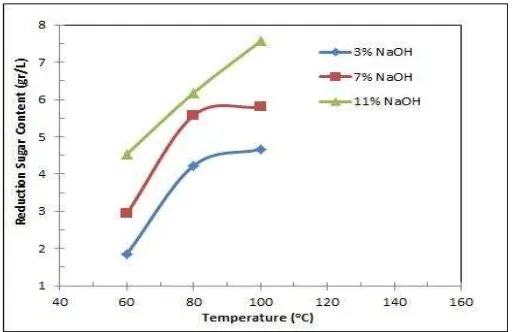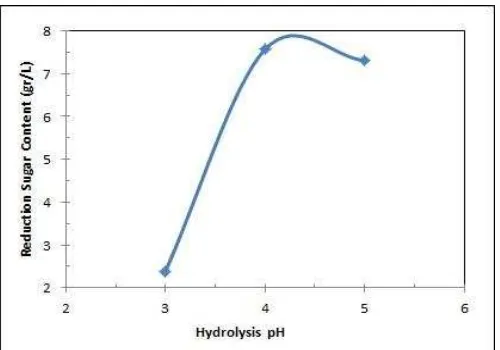Enzymatic Hydrolysis of Alkaline Pretreated Coconut Coir
Akbarningrum Fatmawati a, Rudy Agustriyantoa, Carolina Adheliaa, Jovita Paulinaa, Yusnita Liasarib
a
Chemical Engineering Department, Faculty of Engineering, Surabaya University, Jl. Raya Kalirungkut, Surabaya INDONESIA,
The purpose of this research is to study the effect of concentration and temperature on the cellulose and lignin content, and the reducing sugars produced in the enzymatic hydrolysis of coconut coir. In this research, the coconut coir is pretreated using 3%, 7%, and 11% NaOH solution at 60oC, 80oC, and 100oC. The pretreated coir were assayed by measuring the amount of cellulose and lignin and then hydrolysed using Celluclast and Novozyme 188 under various temperature (30oC, 40oC, 50oC) and pH (3, 4, 5). The hydrolysis results were assayed for the reducing sugar content. The results showed that the alkaline delignification was effective to reduce lignin and to increase the cellulose content of the coir. The best delignification condition was observed at 11% NaOH solution and 100oC which removed 14,53% of lignin and increased the cellulose content up to 50,23%. The best condition of the enzymatic hydrolysis was obtainedat 50oC and pH 4 which produced 7,57 gr/L reducing sugar.
Keywords : coconut, enzyme, hydrolysis, lignocellulose
1. Introduction
The lignocellulosic biomass is represented by the high-level crop, hard wood and soft wood with cellulose, hemicellulose and lignin as the main component. One of the lignocellulosic biomass available in Indonesia is coconut coir. Coconut productivity in Indonesia is very high, reaching 15.5 billion coconuts per year, which is equivalent to 3.02 million tons of copra, 3.75 million tons of water, 0.75 million tons of shell, 1.8 million tons of coir fiber, and 3.3 million tons of coir dust. The coconut manufacturing industries are still largely focused on coconut meat manufacturing, while the manufacturing industry of its byproducts such as coconut water, coconut coir and coconut shell is still in small scale and traditional [1]. Whereas the potential of the byproduct is very large, especially the coconut coir.
Coconut coir is composed of cellulose, lignin, pectin, hemicellulose, and ash. Cellulose is a component of coconut coir that can be processed and converted into energy sources. Lignin is a component of coconut coir that is rigid and prevent the cellulose degradation [2]. The lignin degradation is necessary to increase the rate of the hydrolysis of lignocellulosic materials. This can be done by physical, chemical, and biological method. One method of chemical delignification is pretreatment using some kind of alkaline solutions such as NaOH and Ca(OH)2[3].
The delignification can be carried out using NaOH solution that can attack the structure of lignin and disrupt the crystalline structure of cellulose [3]. In addition, the NaOH is relatively cheap, easily obtained and also more soluble in water than Ca(OH)2 [4].
This research studied the alkaline pretreatment using NaOH solution and the enzymatic hydrolysis of coconut coir. The hydrolysate as intended to be used as biohydrogen fermentation substrate.
2. Materials and Methods
2.1.Materials Preparation
2.2.Alkaline Pretreatment
In this study, the delignification was performed using various concentration of NaOH (3%, 7% and 11%) and temperature of 60°C, 80°C and 100oC. The coconut coir loading was 15 grams in 200 ml solution of NaOH. The pretreatment process was conducted in a reactor with reflux for 60 minutes. After alkaline treatment, the solid was filtered and then neutralized using distilled water and dried. Subsequently, the dried solid was tested for the content of lignin and cellulose. The experiment was duplicated.
2.3.Enzymatic Hydrolysis
Enzymatic hydrolysis was done using endoglucanase enzymes (Cellulase, Trichoderma reesei ATCC 26 921,
Sig a Aldrich) a d β-glucosidase (Cellubiase, Aspergillus niger, Sigma Aldrich). The cellulase enzyme loading used was 15 FPU/g cellulose while the cellulase to cellobiase ratio was 2 FPU/CBU. The condition of hydrolysis process was maintained at temperature of 40oC, 50oC, 60oC and pH of 3, 4, 5 using 0.05 M citrate buffer. The hydrolysis was carried out for 2 grams of solids in 50 ml of citrate buffer solution in an incubator shaker (GFL brands 3032 models) at a speed of 90 rpm for 72 hours.
This enzymatic reaction was then stopped by heating at 100oC in a waterbath for 5 minutes. Filtration was then performed using filter paper and the reducing sugar content of the filtrate was analyzed.
2.4.Analysis
In this study, the analysis of cellulose and lignin content was conducted by Chesson method [5]. The reducing sugar content analysis performed by the method of DNS (Dinitrosalicylic Acid) [6].
3. Results and Discussion
The raw coconut coir contained 41.70% of cellulose and 30.54% of lignin. After delignification, it was observed that the cellulose content increased to 45.39%-50.23% while the lignin decreased to 26.10%-29.28%.
3.1. The Effect of the Delignification Temperature and NaOH Concentration on the Cellulose Content of Coconut Coir
Many factors could affect the cellulose content of the pretreated coconut coir. The two of them were temperature and concentration of NaOH solution which could be seen in figure 1.
Figure 1. The Cellulose Content of The Coconut Coir after Delignification
The cellulose content of the coconut coir incresed with the delignification temperature. The delignification using 3% NaOH solution at 60oC gave the lowest cellulose content than the delignification at 80oC and 100oC. The cellulose content increased by increasing the concentration of NaOH solution. As seen in figure 1, the delignification at 60oC resulted in the highest cellulose content at 11% NaOH solution.
3.2. The Effect of The Delignification Temperature and NaOH Concentration On The Lignin Content of Coconut Coir
The lignin content of pretreated coconut coir was also affected by temperature and concentration of NaOH solution, as shown in figure 2.
Figure 2. The Lignin Content of The Coconut Coir after Delignification
At concentrations of 3%, 7%, and 11% NaOH, the remaining lignin content at 60oC was higher than 80oC. The lowest remaining lignin content was observed at 100oC for a particular concentration of NaOH. The remaining lignin content in the coconut coir decreased with temperature. The variation of concentration also gave the same effect to lignin content of the coconut coir. The higher concentration of NaOH decreased the lignin content of the coconut coir.
The correlations of delignification temperature and NaOH solution concentration with the remaining lignin content of coconut followed the Arhenius theory as shown in equation 1 and 2.
)
same concentration (C), the rate of reaction (
A
r
) would increase. Similarly, at the same temperature (T), if the concentration (C) increased, the rate of reaction would also rise. The increased of the reaction rate would speed up the process of lignin removal, and hence more lignin would be removed and more cellulose would be obtained.
3.3. The Reducing Sugar Content of the Hydrolysates
Table 1. The Reducing Sugar of The Pretreated Coconut Coir
Delignification Condition Reducing Sugar (gr/L) Concentration of NaOH (%) Temperature (oC)
3
60 1.85
80 4.23
100 4.67
7
60 2.94
80 5.58
100 5.80
11
60 4.53
80 6.18
100 7.57
As shown in Table 1, it could be concluded that the delignification could increase the reducing sugar content of coconut coir.
3.4. The Effect of NaOH Concentration on the Sugar Production
The reducing sugar of hydrolyzed coconut coir was affected by the concentration of NaOH solution. In the hydrolysis process at 50oC and pH 4, the result is presented in figure 3.
Figure 3. The Reducing Sugar Content at Various Concentration of NaOH Solution
The increased NaOH concentration enhanced the reducing sugar content of hydrolyzed coconut coir. At 60oC, the lowest hydrolysate reducing sugar concentration was obtained from enzymatic hydrolysis at 3% NaOH solution. This was because the higher concentration of NaOH solution removed more lignin during delignification, hence more available cellulose of coconut coir could be obtained. The more cellulose available obtained after delignification would enhance reducing sugar production in enzymatic hydrolysis.
3.5. The Effect of the Delignification Temperature on the Sugar Production
Besides the concentration of NaOH solution, the temperature of delignification also affected the production reducing sugar in the hydrolysis, as shown in figure 4.
Figure 4. The Reducing Sugar Content at Various Temperature of Enzymatic Hydrolysis
3.6. The Effect of the Hydrolysis pH on the Reducing Sugar Production
After the best condition of delignification was obtained, then it was continued by enzymatic hydrolysis at 50oC with variation of pH 3 and 5. The reducing sugar produced was shown in figure 5.
Figure 5. The Reducing Sugar Content at Various pH of Enzymatic Hydrolysis
The highest reducing sugar was obtained in the hydrolysis at pH 4. At pH 5 the reducing sugar produced was slightly lower than at pH 4, and the lowest one was obtained at pH 3. The optimum pH of hydrolysis in this research was observed at about 4 and 5.
The change of pH could affect the enzyme activity by changing the structure or the charge of the active site of enzyme. At the optimum pH, there was charge suitability between the enzyme and the substrate, so the substrate was exactly placed in the active site of enzyme. Those enzyme and substrate then formed enzyme-substrate complex and produced products. At pH lower than the optimum, the substrate lost its negative charge. The enzyme could not bind the substrate at higher pH because it was ionized and lost its positive charge [7].
3.7. The Effect of Hydrolysis Temperature on the Sugar Production
Figure 6. The Reducing Sugar Content at Various Temperature of Enzymatic Hydrolysis
The hydrolysis at pH 4 and 40oC, resulted in reducing sugar concentration slightly lower than that which carried out at 50oC. At 60oC, the reducing sugar concentration was much lower than those obtained at 50oC and 40oC. In other words, the highest reducing sugar was observed from hydrolysis at pH 4 and 50oC. The optimum hydrolysis temperature seemed to occur at temperature between 40-50oC. This could be concluded from the difference of reducing sugar produced from hydrolysis at 50oC and 40oC, where they were only slightly different. This behavior might be due to a temperature range between 40oC-50oC was very close to the optimum temperature of the enzyme, so that the enzyme was almost reached its optimal activity and the reducing sugar produced did not differ significantly or nearly constant. This followed the biochemical theory which stated that the thermal denaturation of the enzyme as a type of protein could occur at temperature of 45oC-50oC. Above 50oC enzyme gradually became inactive due to denatured protein [8].
4. Conclusion
The delignification of coconut coir using dilute NaOH solution was effective to reduce lignin content and increase cellulose content of the coconut coir. The increasing temperature and concentration of NaOH would increase the amount of lignin removed, and hence as well as reducing sugars produced. The best condition of the delignification was observed at 11% NaOH solution and 100oC which removed 14.53% of lignin content and increased the cellulose content up to 50.23%. The best condition of the enzymatic hydrolysis was obtainedat 50oC and pH 4 which produced 7.57 gr/L reducing sugar. This was the maximum reducing sugar concentraion that could be achieved.
Acknowledgements
The authors gratefully acknowledge Surabaya University for facilitating this work.
Reference
[1] Tim Badan Penelitian dan Pengembangan Pertanian. 2005. Prospek dan Arah Pengembangan Agribisnis Kelapa. Departemen Pertanian, Jakarta.
[2] Rajan A, Senan RC, Pavithran C, Abraham TE. 2005. Biosoftening of Coir Fiber Using Selected Microorganisms. Bioprocess
Biosyst Eng, 28 : 165-173.
[3] Harmsen PFH, Huijgen WJJ, Lopez LMB, Bakker RRC. 2010.Literature Review of Physical and Chemical Pretreatment Processes for
Lignocellulosic Biomass. Biosynergy.
[4] Green DW, Perry RH. 2008. Physical Properties of Pure Substances. Perry’s Che i al E gi eers’ Ha d ook 8th Ed. The McGraw-Hill Companies, Inc., New York, p.2-11,2-14.
[5] Datta R. 1981. Acidogenic Fermentation of Lignocellluose-Acid Yield and Convertion of Component. Biotechnology and Bioengineering. 23, 2167-2170.




